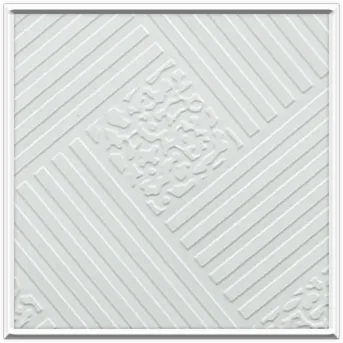- Afrikaans
- Albanian
- Amharic
- Arabic
- Armenian
- Azerbaijani
- Basque
- Belarusian
- Bengali
- Bosnian
- Bulgarian
- Catalan
- Cebuano
- Corsican
- Croatian
- Czech
- Danish
- Dutch
- English
- Esperanto
- Estonian
- French
- German
- Greek
- Hindi
- Indonesian
- irish
- Italian
- Japanese
- Korean
- Lao
- Malay
- Myanmar
- Norwegian
- Norwegian
- Polish
- Portuguese
- Romanian
- Russian
- Serbian
- Spanish
- Swedish
- Thai
- Turkish
- Ukrainian
- Uzbek
- Vietnamese
Dhj . 23, 2024 17:01 Back to list
Exploring Drop Ceiling Grid Materials for Enhanced Interior Design and Functionality
Exploring Drop Ceiling Grid Materials An Essential Guide
When it comes to designing or renovating a space, the ceiling often plays a crucial yet overlooked role. A drop ceiling, also known as a suspended ceiling, has gained popularity in both commercial and residential settings due to its aesthetic appeal and practical advantages. One key component that significantly influences the efficacy and appearance of a drop ceiling is the grid material. This article delves into the various materials used in drop ceiling grids, their characteristics, advantages, and implications for installation and maintenance.
What is a Drop Ceiling?
A drop ceiling consists of a secondary ceiling that hangs below the main structural ceiling. The grid serves as a framework to hold ceiling tiles or panels, allowing for easy access to the space above for plumbing, electrical work, or maintenance. Drop ceilings can enhance acoustics, conceal imperfections, and improve insulation while offering a plethora of design options.
Common Materials for Drop Ceiling Grids
1. Metal
Metal grids are among the most popular and durable options for drop ceilings. Made from materials such as galvanized steel or aluminum, they provide excellent strength and longevity. Metal grids typically come pre-finished, which helps resist corrosion and rust. They are commonly found in commercial spaces due to their aesthetic versatility and robust characteristics.
Advantages - High durability and resistance to moisture and corrosion. - A polished look that complements modern design aesthetics. - Available in various finishes, including painted and chrome options.
2. Vinyl
Vinyl grid systems provide a lightweight alternative to metal grids while still offering significant strength. This material is particularly well-suited for humid environments, such as bathrooms or restaurants, as it is impervious to moisture and won't rust or corrode.
Advantages - Lightweight and easy to install, resulting in reduced labor costs. - Mold and mildew resistant, making it suitable for high-humidity areas. - Variety of colors and finishes available, enhancing design flexibility.
drop ceiling grid materials

3. Wood
For those looking for a more natural and warm aesthetic, wooden grids can provide a unique and inviting atmosphere. Though they may require more maintenance to prevent potential damage from moisture, properly treated wood can be a stunning addition to a drop ceiling design.
Advantages - Adds a cozy and sophisticated touch to any room. - Customizable in terms of species, finish, and style. - Environmentally friendly option if sourced responsibly.
4. PVC
PVC or Polyvinyl Chloride grids are becoming increasingly popular due to their lightweight nature and excellent moisture resistance. They are particularly ideal for installations in areas prone to spills or high humidity, such as basements and kitchens.
Advantages - Low maintenance and easy to clean. - Resistant to mold, mildew, and moisture. - Available in various colors and textures, allowing for creative designs.
Installation Considerations
Choosing the right material for your drop ceiling grid not only affects the aesthetic of the space but also influences installation complexity and overall cost. Metal grids require precise alignment and may be heavier, while lighter materials like vinyl can simplify the installation process.
It's essential to consider the weight of the tiles being used, as heavier tiles will necessitate a sturdier grid system. Additionally, local building codes may dictate specific materials or installation methods, so consulting with a professional is advisable.
Conclusion
The choice of drop ceiling grid materials significantly impacts the functionality, aesthetics, and overall success of your ceiling design. From metal’s durability to vinyl’s resistance to moisture, each material provides unique benefits that cater to different needs and environments. Whether you're enhancing a commercial workspace or creating a cozy home setting, careful consideration of your options will ensure that your drop ceiling is both visually appealing and functional. As trends in interior design continue to evolve, the versatility of drop ceilings and their materials will undoubtedly remain a crucial element in creating dynamic and practical spaces.
-
Transform Interiors with PVC Gypsum Ceiling: A Stylish, Durable, and Moisture-Resistant SolutionNewsMay.19,2025
-
The Smart Interior Upgrade: Discover the Durability and Versatility of Gypsum Ceiling Access Panel SolutionsNewsMay.19,2025
-
The Smart Choice for Interior Design: Discover the Value of PVC Gypsum Ceiling SolutionsNewsMay.19,2025
-
Mineral Fiber Ceiling Tiles: The Smart Blend of Performance and AestheticsNewsMay.19,2025
-
Mineral Fiber Ceiling Tiles: The Superior Choice Over Gypsum for Sound and Fire SafetyNewsMay.19,2025
-
Mineral Fiber Ceiling Tiles: Eco-Friendly Strength and Style for Every CeilingNewsMay.19,2025







